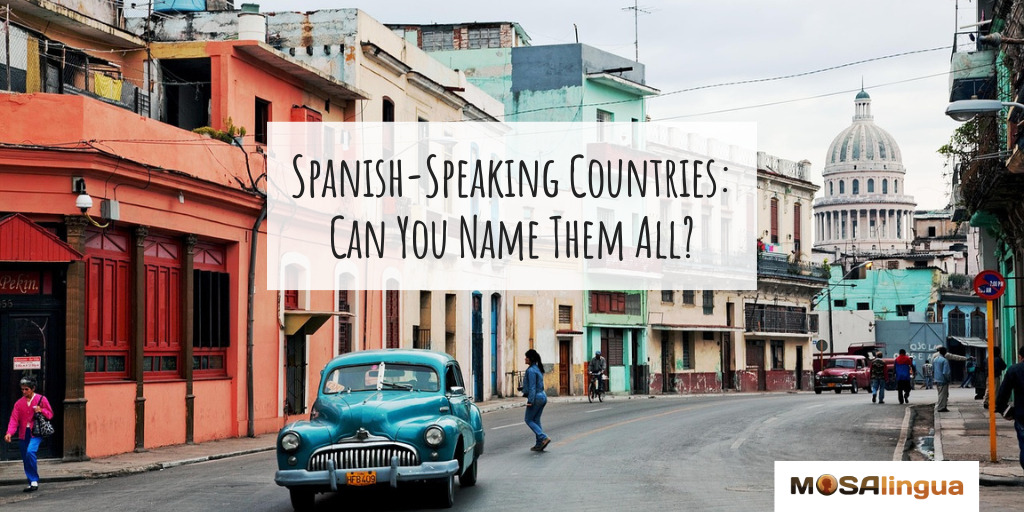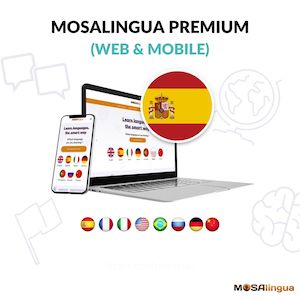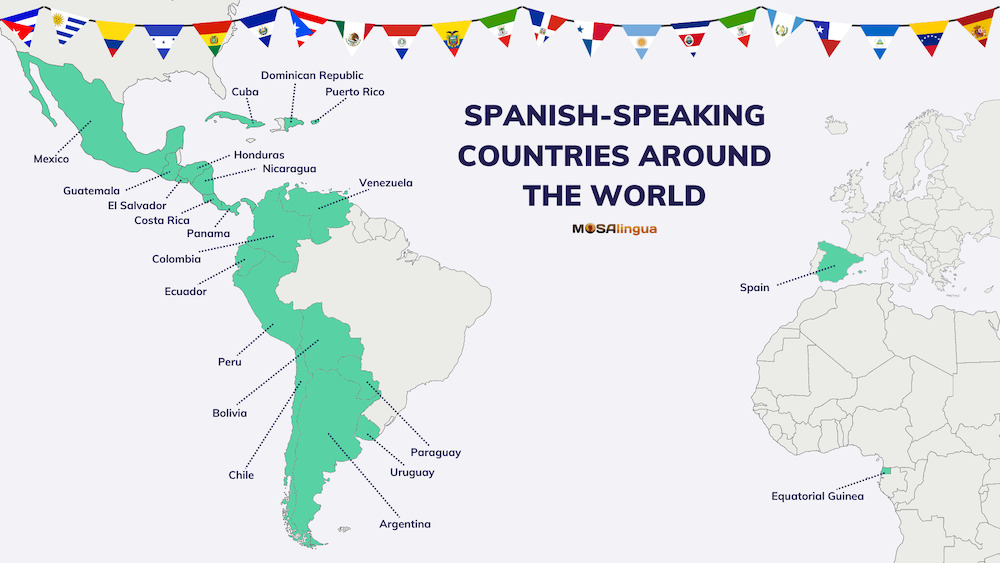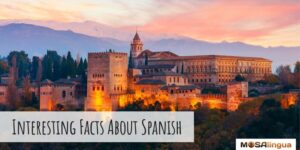Spanish is everywhere: from the meteoric rise of reggaeton artists like Bad Bunny to the growing popularity of remote-working in various Spanish-speaking countries, there’s never been a better time to brush up on your ¿Hola, como está? Spanish will also take you to tons of places around the globe, from the mountains of South America to the beaches of the Caribbean and the lively and historic streets of Europe. Let’s explore all the places in the big wide world where Spanish is spoken!

List of Spanish-Speaking Countries
You might already have an idea of the powerhouse language that Spanish is.
Almost 600 million people worldwide speak Spanish, and this amazing number includes everyone from native speakers to Spanish learners. It’s the second-most spoken native language in the world after Mandarin Chinese, and the fourth-most spoken language overall after English, Mandarin Chinese, and Hindi.
In this article, we’ll learn about all the places where Spanish is spoken. Some of them might surprise you!
Maybe you only know that they speak Spanish in Mexico and Spain, or maybe you can name every country and territory where Spanish is an official language. So, exactly how many Spanish-speaking countries are there? Here’s a list:
- Argentina
- Bolivia
- Chile
- Colombia
- Costa Rica
- Cuba
- Dominican Republic
- Ecuador
- El Salvador
- Equatorial Guinea
- Guatemala
- Honduras
- Mexico
- Nicaragua
- Panama
- Paraguay
- Peru
- Puerto Rico
- Spain
- Uruguay
- Venezuela
Including Puerto Rico, there are 21 Spanish-speaking countries and territories. There are even a few more countries where Spanish is a widely spoken or native language without being an official one!
Map the Spanish-Speaking Countries
The Spanish language is connected to so many different countries and cultures around the world. Take a look at the Spanish-speaking countries map below to see just how global Spanish is:
📌 Like this infographic? Pin it to your language inspiration Pinterest board or print it!
By the way, did you notice what that banner is along the top? It’s all the Spanish-speaking countries’ flags! Do you recognize any of them?
Now it’s time to learn about each Spanish-speaking country, continent by continent.
Spanish-Speaking Countries Around the World
North America
Did you know that North America has more Spanish speakers than any other continent? The combined forces of Mexico and the US make up about 187 million Spanish speakers—almost one-third of the global population of Spanish speakers!
USA
While English is the de facto language of the US (there is no official language), Spanish is the second-most spoken language in the country, spoken by about 55 million people. There are neighborhoods, cities, and even entire regions in the US where you need to speak at least some Spanish to get by. If you’ve been to Miami or parts of New Mexico, you know what I mean!
The US also has the highest number of Spanish learners in the world. If you grew up in the US, you probably had the chance to take Spanish in secondary school. Spanish is a crucial part of the linguistic landscape of the US, and that’s not changing anytime soon. More official and social recognition and accommodation of Spanish will help the language and its speakers thrive in the US.
Mexico
In terms of speakers, Mexico is the largest Spanish-speaking country, with about 130 million speakers. Mexican Spanish is a rich and colorful collection of dialects that are marked by the presence of MANY slang words, so if you’re in Mexico, keep your ears peeled to listen for fun new words to add to your Spanish vocabulary!
Central America
There are six countries that speak Spanish in Central America. What’s more, the jungles and islands of Central America are home to approximately 39 million Spanish speakers, which is a pretty hefty number of speakers!
The most distinctive feature of Central American Spanish is the voseo, which refers to the use of the second-person singular pronoun vos instead of the formally accepted second-person singular pronoun tú.
Here are the countries in Central America that speak Spanish:
- Costa Rica
- El Salvador
- Guatemala
- Honduras
- Nicaragua
- Panama
Start improving your Spanish today

Good news: we can help!
More good news: you can get started for free! With your free trial, you can test drive the most effective method for learning Spanish for the next 15 days!
Vocabulary flashcards, videos with subtitles, audiobooks, articles adapted to your level – with MosaLingua Premium (Web & Mobile), you’ll have access to all this and more. Get started right now. It’s free—and risk-free—to try!
South America
When you think of where in the world people speak Spanish, you probably think of South America. A huge population of more than 210 million people speaks Spanish in South America—but surprisingly, that’s only about half of the continent’s population. (Is Brazil a Spanish-speaking country? No! And a LOT of people live there.)
Other predominant languages of South America include English, French, Portuguese, and a vast variety of indigenous languages.
But as for Spanish, South America is home to lots of interesting dialects, like the musical, Italian-influenced Argentinian Spanish and the extremely rapid, blink-and-you’ll-miss-it Chilean Spanish.
Here are the South American Spanish-speaking countries:
- Argentina
- Bolivia
- Chile
- Colombia
- Ecuador
- Paraguay
- Peru
- Uruguay
- Venezuela
Caribbean
The Caribbean is a tropical melting pot of many cultures, predominantly African, Spanish, and indigenous. So it’s no surprise that there are three Spanish-speaking countries in the Caribbean, totaling 28 million speakers.
Spanish Caribbean culture is rich and globally popular: for instance, reggaeton, the music genre whose popularity has recently exploded into the mainstream, along with bachata and dembow, other influential Spanish music genres, all originated in the Caribbean.
The Spanish spoken in these countries is incredibly fast and peppered with a wide variety of slang. Here are the Spanish-speaking countries of the Caribbean:
- Cuba
- The Dominican Republic
- Puerto Rico
Africa
If you thought there weren’t any African countries that speak Spanish, think again! There are an estimated one to two million Spanish speakers in Africa, and the Central African nation of Equatorial Guinea is home to most of them, with 68% of its population speaking Spanish.
There are also small scattered communities of Spanish speakers elsewhere in Africa, mostly concentrated in or near Morocco, which is next door to Spain.
Asia
Although the Philippines was a Spanish colony for hundreds of years, with its de facto language being Spanish during that time, nowadays only about 4% of the population speaks Spanish. However, the official Filipino language (which is similar to or the same as Tagalog, depending on who you ask) is heavily influenced by Spanish: approximately one-third of its words are of Spanish origin! That being said, Filipino is not mutually intelligible with Spanish. This means that speakers of one language cannot understand speakers of the other.
There’s also a separate Spanish creole spoken by about one million people in the Philippines called Chavacano. This creole language is actually somewhat understandable if you speak Spanish—pretty cool, right?
At the end of the day, though, don’t rely on Spanish to get you around the Philippines. You’ll need to learn Tagalog instead!
Europe
Last but not least is the motherland: Spain! Spanish originated on the Iberian peninsula, in the area we now call Spain. Here’s a quick history lesson about how the Spanish language came to be:
Spanish descends from Latin—specifically from Vulgar Latin, which was the form of everyday Latin spoken by ordinary people as opposed to the standardized version used in more official settings. The Romans brought Latin to the area in approximately 200 BC, and dialects of Latin functioned as the everyday language of the area from then on.
After the fall of the Roman empire, Muslim rule overtook parts of Spain for hundreds of years, and Arabic dialects mixed with the Latin dialects already being spoken.
After the Kingdom of Castile reconquered the Iberian Peninsula from Muslim rule during the Reconquista in the 13th century, Castilian Spanish influenced by Arabic arose as the dominant language of the area.
This dialect eventually turned into Castilian Spanish (or just “Castilian”), the language spoken in Spain today. From there, widespread Spanish colonialism in the 16th century brought the Spanish language all over the world.
Castilian Spanish differs from other forms of Spanish in a few key ways. First, it makes use of the “vosotros” conjugation, which is the informal third-person conjugation. Most other forms of Spanish only make use of the formal third-person conjugation. There’s also the famous Spanish “lisp,” or ceceo. But it’s not actually a lisp (and some Spaniards might be offended if you call it that). It’s just a particular pronunciation of the letters s, c, and z in certain linguistic contexts, and it’s only found in Castilian Spanish.
Bonus Spanish-Speaking Places
Belize
Belize is a small Central American country whose official language is English. However, anywhere from one-third to one-half of Belize’s population speaks Spanish, making it a significant language in the country.
Andorra
Andorra is a teeny tiny country between Spain and France. The official language is Catalan, but since it’s so close to Spain, Spanish is also widely spoken there.
Gibraltar
Gibraltar is a small British Overseas Territory on the coast of southeastern Spain. Its official language is English, but much like Andorra, its proximity to Spain means that many people in Gibraltar speak Spanish.
Next Steps
Learning Spanish?
- Impress Your Friends with These 15 Fun Facts About Spanish
- Spanish: Easy for English Speakers?
- What’s the Difference Between Spanish Accents and How Do You Choose the Right One?
Curious about languages in general? Find out more about the languages in other countries around the world:
- What Language Do They Speak in Belgium? Is Belgian a Language?
- How Many of These Languages in India Have You Heard Of?
- What Is the Main Language in Luxembourg?
- What Language Do They Speak in Brazil? Brazilian? 🤔





Comments